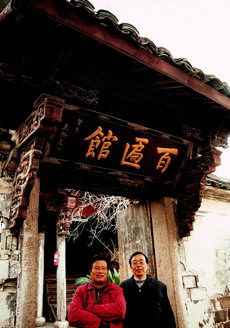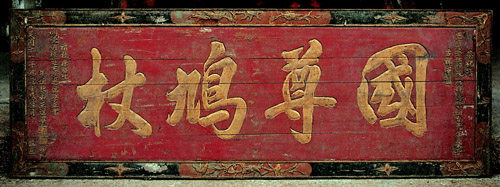“以匾研史,可以佐证;以匾习书,可获笔意;以匾读辞,可得精髓”,请看——

早就知道根雕艺术大师郑剑夫情系古匾,收藏古匾近千块,是个“匾迷”,不久前浙江省民族民间艺术保护工程专家委员会还授予他“收藏保护奖”。我振奋之余,在一个爽朗的晴天专程随他前往嵊州古村华堂“百匾馆”,一睹那些在光阴长河里沉淀下来的匾额。
出嵊城,跑车轻盈地驶行在坦荡的路面上,谈笑间20多公里路程倏忽即至。
金庭镇华堂村古名桐柏庄,自晋王羲之交卸郡篆,仰慕剡县(今嵊州市)秀山丽水,归隐素有“二十七洞天”之称的金庭后,书圣一脉一直在此生息繁衍。据《王氏宗谱》记载,晋书法家王羲之的三代子孙均善书画,时人曾称此地为“画堂”,又因这里东有金庭山、北有石鼓山,濒临平溪江,加之景色华丽,后人遂取谐音,易名“华堂”。
华堂村卧波小桥,飞檐古祠,与千年牌坊和阡陌相连的田园交融成一幅水墨画,踏着绿茵中鹅卵石铺就的小径,我们似乎从画中来到“百匾馆”。迎面一座青砖砌就的外墙大门上,“百匾馆”金字匾额熠熠闪亮。
院内有一天井,暖阳朗照,花草衬映。馆内那琳琅满目、历尽沧桑的古匾,犹似一本本敞开了的浸透了传统文化的大书。

匾也称匾额,源于图腾崇拜和书体流变,它是中华民族古代文明的产物,文化含量巨大,历史信息丰富,艺术形态多姿,思维空间宽广,哲思意味深长。它折射的是社会称颂的道德,寻找的是高山流水的知音,弘扬的是齐家治国的情操,见证的是中华文明的辉煌。说起收藏匾额的缘由,郑剑夫快人快语:“1998年,我去皖南采购雕刻用的根材和古沉木,在农家的猪圈里瞥见一块古匾,沾满粪水的匾体依然可见暗红色的本相。揩去脏污,尚能辨清明代年庚,遗憾的是匾的一角已被猪啃咬得不成模样。当时,我心里那个疼啊,真是难以言状!”从此,他风尘仆仆,跋涉于福建、浙江、江西、安徽、湖南、湖北诸省,“云腾致雨,露结为霜”,终于以数年如一日的艰辛与快乐,唤醒不知沉睡了多少年的古匾,让它们走出乡村,走出山野,走出古宅、书院、殿宇,重见天日,登上大雅之堂。
我在百匾馆“匾巷”间逡巡,目睹在这个灵性的世界里,暗红、藤黄、赭褐、藕灰、缁黑诸色之氤氲,浮雕、阴刻、彩绘、线描、镶嵌之严谨典雅,篆书、隶书、真书、行书、草书之斗奇争艳和褒奖励志、颂德贺岁、祝寿庆喜、叙事崇仰、名人名言之丰瞻博大,那“文章堂”、“文魁”、“奉政大夫”、“风同渭水”、“国尊鸠杖”……,真是一匾一故事,一匾一历史!那镂月裁云的笔意化出气韵生动的东方意象,那金声玉振的雕刀刻出风骨秀异的民族品格,真乃非天工不能夺其势,非鬼神不能穷其妙。一种由人文、史事、民俗、建筑、书法、美学、文化艺术所融就的幻影般的神秘感,让我仿佛乘上了时光的传送带,与原本和我等有云泥之隔的朱熹、王守仁、董其昌、祝允明、徐文长、方孝孺、林则徐诸大家交流对话,真让人感受生命的粗犷和奔放,体味命运的短暂与无常,你在无间的氛围里有了知识的长进、有了领悟后的欢娱……

日上中天,阳光将长空洗得格外清新。我怀着对久远的记忆,恋恋不舍地步出“百匾馆”。老友剑夫见我对古匾痴迷如斯,遂边行边说:“至今,我收藏的古匾已近千块,朝代宋、元、明、清、民国都有,这里展示的仅是冰山一角,绍兴柯岩的‘历代名匾馆’、北京的‘中国科举博物馆’都有我收集的古匾。2003年10月15日,江泽民同志在浙江省委书记习近平、省长吕祖善等陪同下视察了‘历代名匾馆’并为之题词,真让我百感丛生。往后,我将一手抓根雕的创作,一手抓古匾的收藏,更好地保护文化遗产!”闻得此言,我也为之动容,不是么!古匾作为中国特色文化的景观之一,作为中国文化艺术中的瑰宝,在世界上享有盛誉。古人云:以匾研史,可以佐证;以匾习书,可获笔意;以匾读辞,可得精髓。其中所蕴含的有形的物质和无形的精神可谓难以估量。郑剑夫这发自内心的深情,正如草木之于土地,游子之于故园,由此而成的情结自然是永难割舍的。
A Collector of Ancient Plaques
By Xing Zengyao

I had long since learned that Zheng Jianfu was a fanatical collector of ancient plaques. Recently, an experts committee for folk arts protection in the province has honored the collector for his protective efforts to rescue ancient plaques. On the other day, I traveled all the way to the ancient village of Huatang in Shengzhou to take a look at his private museum of plaques.
Huatang is more than an ancient village. In the Eastern Jin Dynasty (265-316), Wang Xizhi, presumably the greatest calligrapher in the history of China, resigned from the court and retired to the scenic village. More than 20 kilometers out of Shengzhou, the village looked like a painting: houses with the double-eave roofs, small bridges spanning brooks, age-old memorial archways, and farming fields with crisscrossing footpaths. At the end of a tree-flanked pebble path spread a courtyard. On the grey front wall was the name of the museum: Museum of Hundreds of Plaques. Of course, the title was inscribed in gilt on a plaque. Beyond the wall was a large dooryard where the sunshine splashed luxuriously on flowers. Inside, on display were hundreds of plaques.
Plaques point to an ancient Chinese art that combines ancient totem worship and calligraphy. They date back to the country’s earliest days. They display history, art, philosophy, social virtue and responsibility, lifestyle, family mottos and aspirations, best wishes and celebrations. In short, they stand eloquent witness to China as an ancient civilization.

How come Zheng Jianfu started to collect these plaques? The enthusiasm got ignited in 1998 when he traveled to the southern part of the neighboring Anhui Province on a business trip to seek and buy tree roots and water-logged timber as raw materials for his creative sculptures. In one village, he spotted a plaque in a pigsty at a farmer’s house. After the plaque was retrieved and cleaned, he could see it was made in the Ming Dynasty (1368-1644). One corner was totally damaged by the gnawing of pigs. It made his heart ache to see such senseless waste. He decided then and there to rescue plaques no matter where they were. He searched widely across provinces over years. His efforts paid off and gradually and steadily his collection of ancient plaques grew.
I wandered inside the museum, fascinated by these plaques. A great variety of calligraphic styles, artistries, celebrated quotations could be seen, a great variety of arts went into the making of these treasures, and a great amount of essences of Chinese culture went into the inscriptions on these plaques. One can easily detect, on these plaques, the teachings of great scholars and thinkers in the country’s history.
After the unforgettable experience inside the museum, I walked out with certain reluctance. The sun was high in the sky. Memories of the past were still with me. Zheng told me more about his collection.
It turned out that he has rescued nearly 1,000 plaques. The museum in the village holds only part of his precious collection. Some of his plaques are displayed in a plaques museum in Keqiao, Shaoxing and some are in the collection of Beijing-based Imperial Examination Museum. On October 15, 2003, President Jiang Zemin, accompanied by the top provincial government officials, visited the museum in Keqiao and wrote an inscription on the occasion for the museum.
As an artist of root sculpture, Zheng understands the importance of these plaques. He explains, “These plaques are unique treasures of the Chinese culture. No other countries and regions in the world have such things. I feel obliged to promote our cultural heritage.”His remark reminded me of ancient sages’statements that plaques offer insight into history, provide lectures on the art of calligraphy, and teach how to write succinctly and poetically.
(Translated by David)
